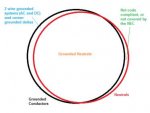mwilson87a
Member
- Location
- Byron Center, Michigan
Why?
Why?
Neutral and Ground differ in that one is a current carrying and one is not. They are both at 0V in reference to earth.
In your transformer, provided the secondary side is isolated from the primary (ie, not an autotransformer, etc...) you will have a voltage between your terminals that follows the waveform you put on the primary side (for the most part.)
You can hook things up to these terminals and run them just fine, but realize each terminal would be at some unknown voltage at all times. Saying ZERO volts would be somewhere in the middle of the secondary coil is SOMEWHAT accurate, but you'll never be able to find it.
You GROUND one of the terminals on the secondary side to set it to ZERO volts. Now you should branch from that terminal ONLY for your AC power on the secondary side, DO NOT try and use a ground elsewhere for your common. Neutral term is just a word to describe a zero potential line that is current carrying. There are a LOT of myths on what/how/why, but simply put, it comes from the need to keep people safe and stems from the light socket. The light socket is very unsafe. You screw a bulb in and the treads are live right away. This is where the POLARIZED plugs in homes came from. This helps keep the NEUTRAL, 0V, connection to the treaded portions. The 0V assignment came out of safety concerns.
Later on, the 3 wire system, with a HOT, NEUTRAL and then GROUND came into play. This was very ingenious. You have your hot, your 0V current carrying neutral for any exposed connections, then the ground is used to ensure any conductive surfaces will conduct current away should the HOT/NEUTRAL be hooked up wrong, the HOT comes loose, etc. Additionally, the flow of current in the neutral, though zero volts, can be cross compared to the ground and neutral-ground faults can also be detected.
So, WHY the names? HOT means OUCH, that's hot. NEUTRAL means safe, but what you use, and GROUND means earthed directly.
Why?
Neutral and Ground differ in that one is a current carrying and one is not. They are both at 0V in reference to earth.
In your transformer, provided the secondary side is isolated from the primary (ie, not an autotransformer, etc...) you will have a voltage between your terminals that follows the waveform you put on the primary side (for the most part.)
You can hook things up to these terminals and run them just fine, but realize each terminal would be at some unknown voltage at all times. Saying ZERO volts would be somewhere in the middle of the secondary coil is SOMEWHAT accurate, but you'll never be able to find it.
You GROUND one of the terminals on the secondary side to set it to ZERO volts. Now you should branch from that terminal ONLY for your AC power on the secondary side, DO NOT try and use a ground elsewhere for your common. Neutral term is just a word to describe a zero potential line that is current carrying. There are a LOT of myths on what/how/why, but simply put, it comes from the need to keep people safe and stems from the light socket. The light socket is very unsafe. You screw a bulb in and the treads are live right away. This is where the POLARIZED plugs in homes came from. This helps keep the NEUTRAL, 0V, connection to the treaded portions. The 0V assignment came out of safety concerns.
Later on, the 3 wire system, with a HOT, NEUTRAL and then GROUND came into play. This was very ingenious. You have your hot, your 0V current carrying neutral for any exposed connections, then the ground is used to ensure any conductive surfaces will conduct current away should the HOT/NEUTRAL be hooked up wrong, the HOT comes loose, etc. Additionally, the flow of current in the neutral, though zero volts, can be cross compared to the ground and neutral-ground faults can also be detected.
So, WHY the names? HOT means OUCH, that's hot. NEUTRAL means safe, but what you use, and GROUND means earthed directly.

